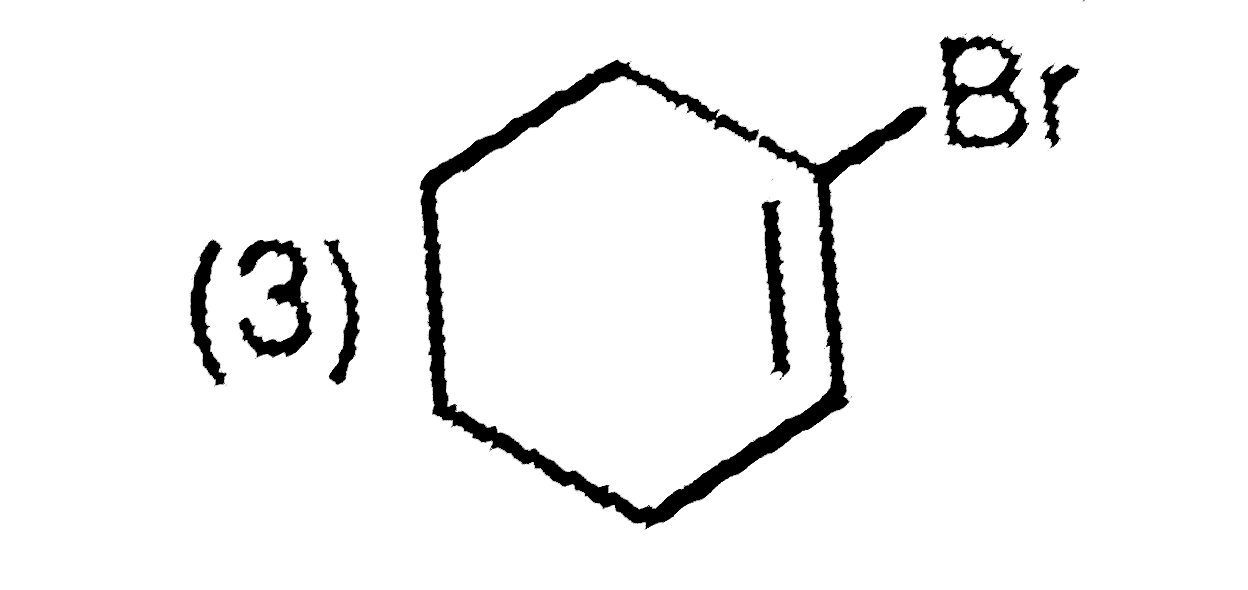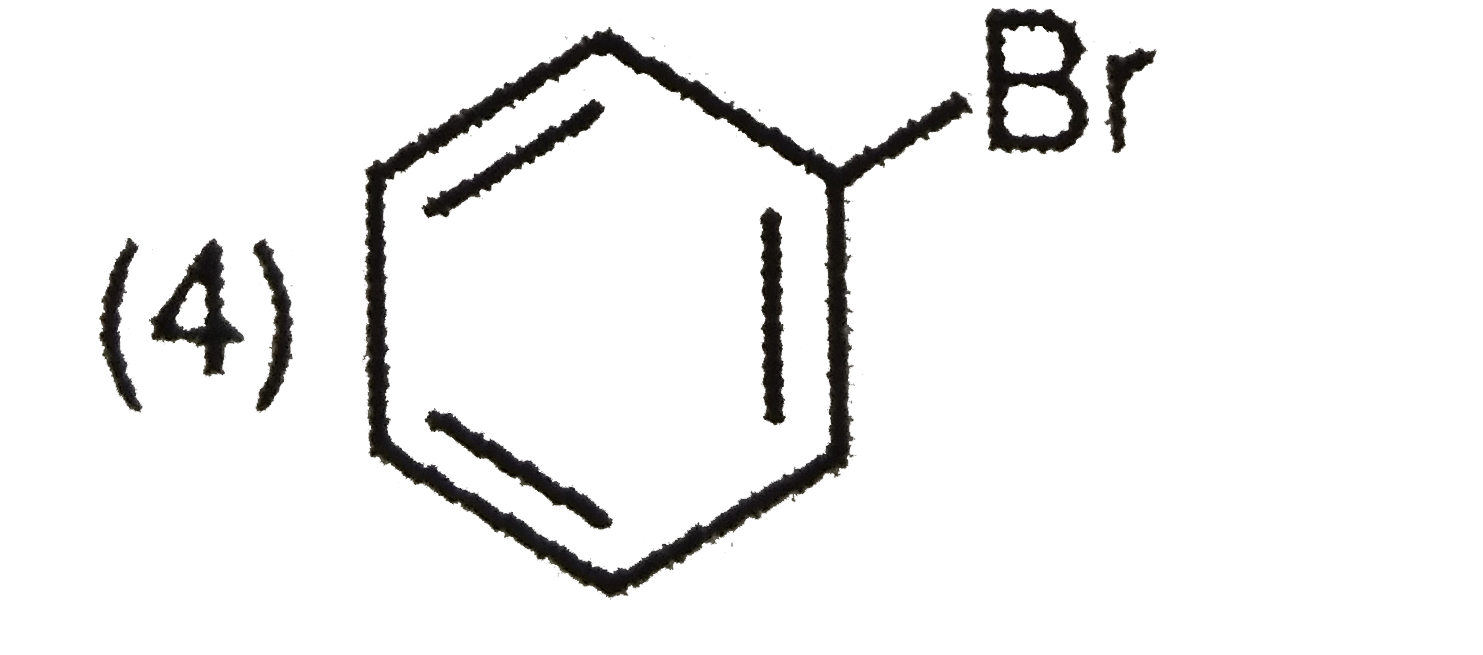Which of the following will most readily give the dehydrohalogenation product ?




The correct Answer is:A
To determine which compound will most readily undergo dehydrohalogenation, we need to analyze the stability of the resulting alkyne after the removal of HBr from each option. Dehydrohalogenation involves the elimination of a hydrogen atom and a halogen atom (in this case, bromine) from a compound, typically resulting in the formation of a double or triple bond.
1. Understanding Dehydrohalogenation:
- Dehydrohalogenation refers to the elimination of HBr (hydrogen bromide) from an alkyl halide, leading to the formation of a double bond (alkene) or a triple bond (alkyne).
2. Analyzing the First Compound:
- The first compound has a bromine atom attached to a carbon that is part of a conjugated system (multiple double bonds).
- The presence of resonance in this compound stabilizes the resulting alkyne after the removal of HBr.
- The alpha hydrogen (the hydrogen adjacent to the bromine) is removed, leading to the formation of a stable alkyne.
3. Analyzing the Second Compound:
- The second compound also has a bromine atom and some conjugation, but it is less extensive than in the first compound.
- While it can undergo dehydrohalogenation, the resulting alkyne is less stable due to the lower degree of resonance compared to the first compound.
4. Analyzing the Third Compound:
- The third compound is cyclohexene with a bromine atom.
- The sp2 hybridized hydrogen adjacent to the bromine can be removed, but the resulting alkyne lacks resonance stabilization, making it less favorable than the first compound.
5. Analyzing the Fourth Compound:
- The fourth compound is bromobenzene.
- The removal of HBr leads to the formation of benzyne, which is known to be unstable.
- Due to this instability, this compound is not likely to undergo dehydrohalogenation readily.
6. Conclusion:
- After analyzing all options, the first compound is the most stable due to resonance, making it the most likely to undergo dehydrohalogenation readily.
- Therefore, the correct answer is Option A.
- Dehydrohalogenation refers to the elimination of HBr (hydrogen bromide) from an alkyl halide, leading to the formation of a double bond (alkene) or a triple bond (alkyne).
- The first compound has a bromine atom attached to a carbon that is part of a conjugated system (multiple double bonds).
- The presence of resonance in this compound stabilizes the resulting alkyne after the removal of HBr.
- The alpha hydrogen (the hydrogen adjacent to the bromine) is removed, leading to the formation of a stable alkyne.
- The second compound also has a bromine atom and some conjugation, but it is less extensive than in the first compound.
- While it can undergo dehydrohalogenation, the resulting alkyne is less stable due to the lower degree of resonance compared to the first compound.
- The third compound is cyclohexene with a bromine atom.
- The sp2 hybridized hydrogen adjacent to the bromine can be removed, but the resulting alkyne lacks resonance stabilization, making it less favorable than the first compound.
- The fourth compound is bromobenzene.
- The removal of HBr leads to the formation of benzyne, which is known to be unstable.
- Due to this instability, this compound is not likely to undergo dehydrohalogenation readily.
- After analyzing all options, the first compound is the most stable due to resonance, making it the most likely to undergo dehydrohalogenation readily.
- Therefore, the correct answer is Option A.
Topper's Solved these Questions
- ORGANIC REACTION MECHANISMS-IVBOOK - RESONANCE ENGLISHCHAPTER - ORGANIC REACTION MECHANISMS-IVEXERCISE - APSP PART-1
30 Videos
- ORGANIC REACTION MECHANISMS-IVBOOK - RESONANCE ENGLISHCHAPTER - ORGANIC REACTION MECHANISMS-IVEXERCISE - APSP PART-2
17 Videos
- ORGANIC REACTION MECHANISMS-IVBOOK - RESONANCE ENGLISHCHAPTER - ORGANIC REACTION MECHANISMS-IVEXERCISE - Exercise-3 Part-2 JEE (MAIN ) OFFLINE PROBLEMS
10 Videos
- ORGANIC REACTION MECHANISMS - IIBOOK - RESONANCE ENGLISHCHAPTER - ORGANIC REACTION MECHANISMS - IIEXERCISE - APSP Part - 3
22 Videos
- PERIODIC TABLE & PERIODICITYBOOK - RESONANCE ENGLISHCHAPTER - PERIODIC TABLE & PERIODICITYEXERCISE - ORGANIC CHEMISTRY(BASIC CONCEPTS)
27 Videos
Similar Questions
Knowledge Check
Which of the following reaction is expected to readily give a hydrocarbon product in good yield ?
ARCOOKElectrolytic−−−−−−→OxidationBRCOOAgI2−−→CCH3CH3Cl2/hv−−−→D(CH3)3CClC2H5OH−−−−→Which of the following reaction is expected to readily give a hydrocarbon product in good yield ?
ARCOOKElectrolytic−−−−−−→OxidationBRCOOAgI2−−→CCH3CH3Cl2/hv−−−→D(CH3)3CClC2H5OH−−−−→Which of the following reaction is expected to readily give a hydrocarbon product in good yield ?
ARCOOKElectrolytic−−−−−−→OxidationBRCOOAgI2−−→CCH3CH3Cl2/hv−−−→D(CH3)3CClC2H5OH−−−−→
Which of the following will readily loose H−?

View SolutionWhich of the following will readily loose H− ?

View SolutionWhich of the following will be readily soluble I water ?
View SolutionWhich one of the following will most readily be dehydrated in acidic condition?
View SolutionWhich one of the following compounds will be most readily dehydrated ?
View Solution
